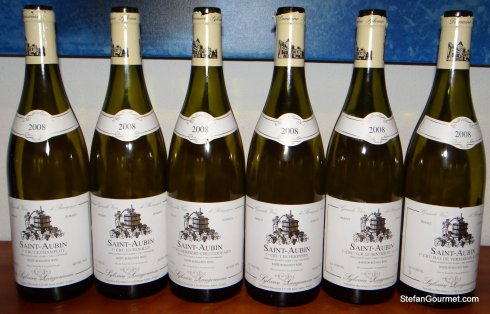Burgundy (Bourgogne) is a region in France that is famous for its wine and its food. Three years ago we went there for a few days to discover the wine region and purchased some nice wines. Most Burgundian wines are at their best between 5 and 10 years from the harvest, and since the wines we purchased were mostly from the vintages 2007 and 2008 it is time to start drinking them. And that’s all the excuse I needed to organize some Burgundian evenings to share the wines with our friends and enjoy them with some good Burgundian food.

Bourgogne is all about terroir, a term that is used to describe where the grapes grow. Although there are some exceptions, most white wines from Bourgogne are made from chardonnay and most reds from pinot noir. Each vineyard produces a different wine even though the same grapes are used, they experience more or less the same weather conditions, and even if the winemaker applies the same winemaking techniques. Wine has been made for a long time in Bourgogne, and the terroir characteristics and quality of each vineyard are well known from experience. The best vineyards are classified as “grand cru”, followed by “premier cru”. The best winemakers are able to create wines that celebrate the unique character of each terroir.
You can purchase a bottle that just says “Bourgogne”, which means that the grapes can be from anywhere within the large area that is Bourgogne. That is not necessarily a bad thing, but usually wine makers will save their best grapes to make something more specific with more character. And so you can narrow it down to a region within Burgundy such as Côte de Nuits, or down to a village such as Puligny-Montrachet, or down to a mixture of the premier cru vineyards within a village such as Chambolle-Musigny 1er cru, or down to a single vineyard such as Puligny-Montrachet 1er cru Champ Gain.

When we visited Burgundy in 2010, we visited a winemaker called Sylvain Langoureau in the town of Saint-Aubin. Saint-Aubin is close to famous wine towns such as Puligny-Montrachet and Meursault and the quality of the terroir (and thus the wines) is almost as high, but it is not as well-known and thus the prices are nicer. Sylvain Langoureau produces Saint-Aubin from six different premier cru vineyards. All of them are chardonnay, all of them use the same wine-making techniques using barriques (15% new). He only uses the wild yeasts that are present on the grapes when they are harvested, and those naturally present yeasts are also considered to part of the terroir. The barriques that are used again the next year, will be used for wine from the same vineyard so that it all stays pure.

When we visited, we tried the six different crus and liked all of them. We were surprised how clearly we could taste the differences, even though these were all the same grape, the same wine-making techniques, the same vintage (and thus weather) and from vinyards that are less than a mile apart from each other. And so we decided to buy some bottles of each of them of the 2008 vintage.

One of the advantages of having 16 people over for a dinner with wine pairings, is that it enables us to open a lot of bottles simultaneously to taste them in comparison to each other and of course paired with matching dishes. And so we also tried the six different crus of 2008 Sylvain Langoureau Saint-Aubin Premier Cru (served with lobster risotto), and everyone was surprised at how easy it was to clearly distinguish between the six different crus. All of them had some nice citrus fruit, some nice roundness, some nice vanilla oakiness, some nice minerality, but the balance between these was different in each wine and that made some more suitable for the lobster risotto than others. It was also interesting to note how the En Remilly, which is closest to Puligny-Montrachet, had the most Puligny-character (i.e. minerality).
The full menu that we had was:
- Jambon Persillé, paired with Aligoté and Rully 1er cru
- Lobster risotto, paired with different crus from Saint-Aubin 1er cru
- Coq au Vin, paired with ligther reds such as Pernand Vergelesses and Pommard 1er cru
- Boeuf Bourguignon (not pressure-cooked but simmered for 2 hours), paired with heavier reds such as Chambolle-Musigny and Aloxe-Corton 1er cru
- Flamusse, a Burgundian apple pie for which I will post the recipe later. Dessert wine does not really exist in Burgundy.


Burgundy wines! What a collection you have. And how lucky were the group of 13 and 16 people.
LikeLike
Let me know when you visit Amsterdam 🙂
LikeLike
But of course!
LikeLike
I love the post. Great bit of education and I can imagine how much fun the evening with the lobster risotto was. I have a frozen lobster in the freezer and I may just risotto it. More when youngest daughter tells me if I can use it for risotto….
LikeLike
Is she a risotto expert you need to confer with? 😉
LikeLike
She has laid claim to the lobster. I think there is a sort of Homer Simpson / Pinchy thing going on. I know you are not a Simpsons follower but look it up here: http://www.youtube.com/watch?v=8MX__0V-c_0
LikeLike
Yes, to answer your question, this turned up in my reader (without the tag “drinking”)
LikeLike
What a great post, Stefan, quite informative. Very generous of you to gather your friends so that they could all taste and experience the wines that you bought while touring Bourgogne. I bet everyone had a fantastic time that evening. 🙂
LikeLike
I saw this on ‘Reader’, but I skip all posts that have to do with alcohol. Sorry.
LikeLike